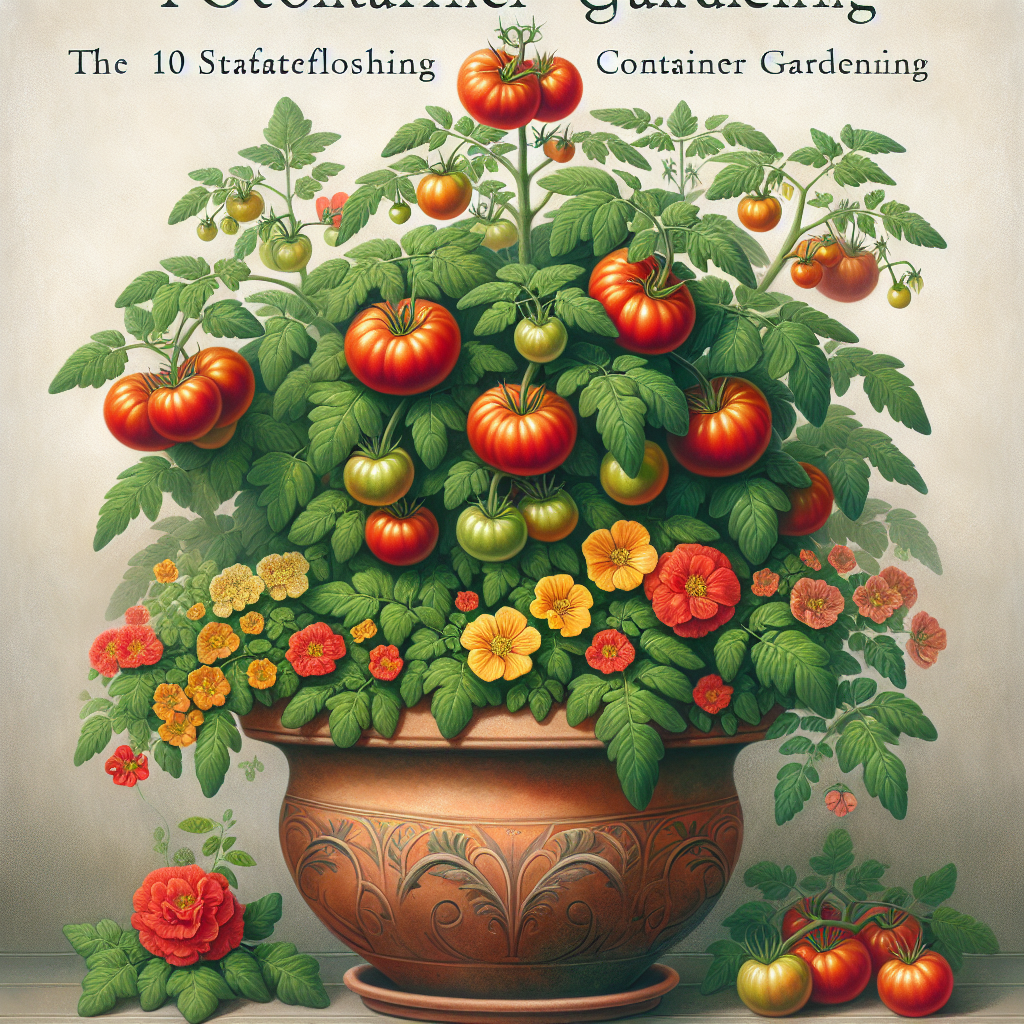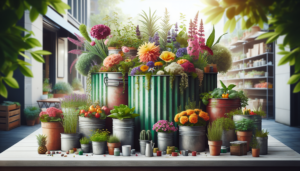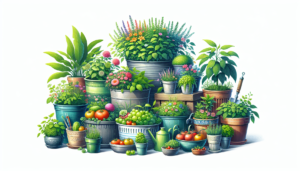
Container gardening is a fantastic way to bring vibrant greenery and fresh fruits and vegetables to your home, even if you don’t have a large outdoor space. Whether you’re a seasoned gardener or just starting out, these 10 tips will help you create a thriving container garden that will make your neighbors green with envy. From choosing the right containers to picking the perfect plants, we’ll guide you through the essentials of successful container gardening, ensuring your plants flourish and your green thumb gets a well-deserved pat on the back. And if you’ve ever wondered about growing your own mushrooms, we’ll even touch on that too! So grab your gardening gloves and let’s get started on this exciting journey towards creating your own beautiful container garden.
Choosing the Right Containers
When it comes to container gardening, one of the first decisions you need to make is choosing the right containers. Consider the size and depth of the container, as it will directly impact the success of your plants. Larger containers are generally better, as they provide more space for root growth and retain moisture better. Deep containers are particularly important for plants with deep root systems.
Another crucial factor to keep in mind is ensuring proper drainage. Without adequate drainage, excess water can accumulate in the container, leading to root rot and other plant health issues. Look for containers that have drainage holes at the bottom or consider drilling holes if necessary. This will allow water to escape and prevent waterlogging.
Additionally, selecting the right material for the container is essential. Common options include clay, plastic, and wood. Each material has its own pros and cons. Clay pots, for example, provide good airflow to the roots but can be heavy and prone to cracking. Plastic containers are lightweight and often more affordable but may not offer as much breathability. Wood containers can provide a natural look and excellent drainage but may require more maintenance. Choose a material that best suits your needs and preferences.
Selecting the Ideal Potting Mix
The potting mix you choose for your container garden plays a vital role in providing the necessary nutrients and support for your plants. It’s crucial to choose a well-draining potting mix to prevent waterlogging and root rot. Look for mixes labeled specifically for container gardening, as they are designed to retain moisture while allowing excess water to drain.
Consider adding organic matter to your potting mix. Organic matter such as compost or well-rotted manure can improve soil structure and fertility, providing a rich source of nutrients for your plants. This organic matter helps with moisture retention, promotes healthy root growth, and enhances overall plant health.
When selecting a potting mix, it’s also advantageous to look for mixes with added nutrients. These nutrient-rich mixes often contain a balanced blend of essential elements like nitrogen, phosphorus, and potassium to support plant growth. Assess the specific needs of your plants and choose a potting mix that aligns with those requirements.
Picking the Right Plants
The success of your container garden relies heavily on choosing the right plants. Take into consideration the location and lighting conditions of your containers. Some plants thrive in full sun, while others prefer partial shade. Assess the amount of sunlight your containers receive throughout the day and choose plants accordingly.
When selecting plants, it’s best to choose varieties that are known to thrive in containers. Look for compact or dwarf varieties that have been bred specifically for container gardening. These plants are often more adaptable to confined spaces and have a better chance of flourishing in containers. Consider factors such as their mature size, water requirements, and pest tolerance.
To create visual appeal in your container garden, mix different plant varieties. Combine plants with contrasting foliage colors, textures, and heights to create an aesthetically pleasing arrangement. This adds interest and diversity to your garden, making it more visually appealing.
Providing Adequate Watering
Watering is a crucial aspect of container gardening. Develop a watering schedule based on the specific needs of your plants. Some plants require more frequent watering, while others are more drought-tolerant. Overwatering can lead to root rot, while underwatering can cause wilting and stunted growth. It’s important to strike the right balance and avoid extremes.
When watering your containers, it’s essential to water thoroughly. This means watering until water starts to flow out of the drainage holes. Thorough watering ensures that the entire root ball receives moisture and encourages healthy root development. Remember to allow the soil to dry out slightly between waterings to prevent waterlogged conditions.
For those looking for convenience, self-watering containers can be a great option. These containers have built-in reservoirs that store water and allow the plants to draw moisture as needed. While these containers may be more expensive initially, they can save time and effort in the long run by ensuring consistent and efficient watering.
Implementing Proper Feeding
Container plants rely on us to provide them with essential nutrients as they cannot access nutrients from the ground. It’s essential to choose the right fertilizer for your container plants to promote healthy growth. Select a fertilizer that is specifically formulated for container plants, as these tend to have the right balance of nutrients.
When using fertilizers, it is important to follow the manufacturer’s directions carefully. Applying too much fertilizer can result in burned roots and foliage damage. On the other hand, insufficient fertilizer can lead to nutrient deficiencies and stunted growth. Pay attention to the recommended dosage and frequency of application to ensure optimal plant health.
Consider using organic fertilizers for your container garden. Organic fertilizers are derived from natural sources and provide slow-release nutrients that nourish plants over time. They are often more environmentally friendly and can improve the long-term health of your soil and plants. Look for organic fertilizers labeled as suitable for container gardening and follow the instructions provided.
Practicing Regular Pruning and Deadheading
To keep your container plants looking their best and encourage vigorous growth, regular pruning and deadheading are essential. Remove any dead or diseased foliage promptly to prevent the spread of diseases and pests. Pruning also helps maintain an attractive shape and promotes bushier growth.
When pruning, make clean cuts just above a node or branch junction. This encourages new growth to emerge from the right places and prevents the plant from becoming leggy or overgrown. Be sure to use clean and sharp pruning tools to avoid introducing pathogens to your plants.
Deadheading refers to the act of removing spent flowers to encourage continuous blooming. By deadheading, you redirect the plant’s energy from seed production to new flower production, resulting in prolonged flowering and a more visually appealing display. Regular deadheading also prevents the plant from self-seeding and potentially becoming invasive.
Protecting from Pests and Diseases
Container plants can still fall victim to pests and diseases, so it’s crucial to inspect them regularly for any signs of trouble. Look for pests like aphids, spider mites, or mealybugs, as well as signs of disease such as wilting, yellowing leaves, or unusual spots. Early detection allows for prompt treatment and minimizes the risk of severe infestations.
If pests are present, treat them immediately to prevent further damage. There are various organic pest control methods available, such as using insecticidal soaps or natural predators like ladybugs. These methods are safer for the environment and can effectively control pests without harming beneficial insects.
Practicing good hygiene in your container garden also helps prevent the spread of diseases. Regularly remove fallen leaves or debris from the containers, as they can harbor pathogens. Avoid overcrowding plants, as this can lead to poor air circulation and increased disease susceptibility. By implementing these preventive measures, you can minimize the risk of pests and diseases in your container garden.
Understanding Sun and Shade Requirements
Understanding the sun and shade requirements of your container garden is vital for plant health and overall success. Determine the sunlight exposure of your containers by observing them throughout the day. Note the areas of full sun, partial shade, and full shade.
Choose plants that match the specific sun and shade conditions of your containers. Full sun plants require at least six hours of direct sunlight per day, while partial shade plants thrive with a combination of direct sunlight and some shade. Full shade plants, on the other hand, prefer limited to no direct sunlight.
It’s also important to provide shade for plants that need partial sun. This can be achieved by placing the containers in spots that receive morning sun or by using shade cloth or other forms of artificial shade. Offering the right amount of sunlight ensures that your plants can photosynthesize properly and maintain their health and vigor.
Harvesting and Enjoying Your Garden’s Bounty
The joy of container gardening lies in harvesting and enjoying the fruits of your labor. Monitor your plants regularly for maturity, as different crops have varying signs of readiness. For vegetables, look for color changes, firmness, or size as indicators of ripeness. Herbs are often best harvested when they are lush and full, just before flowering.
Harvest your vegetables and herbs when they reach their peak ripeness. This ensures that you can enjoy them at their freshest and most flavorful. Some crops, like salad greens or herbs, can be harvested in a cut-and-come-again fashion, allowing you to continually enjoy fresh produce over time.
Once you’ve harvested your bounty, it’s time to get creative in the kitchen. Experiment with recipes that incorporate your freshly picked vegetables and herbs. From salads and soups to stir-fries and smoothies, there are countless ways to savor the flavors of your container garden.
Experimenting and Learning from Experience
Container gardening provides ample opportunities for experimentation. Try different plant combinations and container arrangements to create unique and visually appealing displays. Mix and match plants with contrasting colors, textures, and growth habits to add interest to your garden.
Keeping a gardening journal can be immensely helpful in tracking your successes and failures. Note down the plants you’ve grown, their performance, and any lessons learned. This documentation allows you to reflect on your experiences, make adjustments, and continuously improve your container gardening skills.
Don’t hesitate to learn from fellow container gardeners and their experiences. Join online communities, attend gardening classes, or participate in local garden clubs. Engaging with like-minded individuals can provide valuable insights, tips, and inspiration to enhance your container gardening journey.
With these comprehensive tips and strategies, you’re well on your way to achieving success in container gardening. Remember to choose the right containers, select the ideal potting mix, pick suitable plants, provide adequate watering and feeding, practice proper pruning and deadheading, protect from pests and diseases, understand sun and shade requirements, harvest and enjoy your garden’s bounty, and continue learning and experimenting along the way. Happy container gardening!







